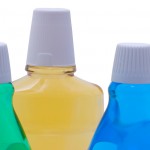
Question:
In dental practice what is the most effective mouthwash for a patient to use to reduce the potential concentration of Covid-19 in the oral cavity ?
Bottom line answer:
From this review four mouthwashes were identified: 0.2% chlorhexidine mouthwash (CHX), 1% povidone iodine (PI) , 1.5% hydrogen peroxide (H2O2), or 0.05% hypochlorous acid (HOCl). CHX had poor virucidal properties and the other three (PI, H2O2,HOCl) all have good virucidal properties but poor microbial substantivity, with the benefits being lost within a few minutes as saliva flow may potentially replace the virus. Of the three the most clinically acceptable in terms of virucidal activity, commercial availability, and taste is the 1.5% hydrogen peroxide.
Background
Two recent papers from China mention the potential use of chlorhexidine in prevention and control of aerosol transmission risk (An et al., 2020; Su, 2020) based on CDC guidelines (Kohn et al., 2003). There are also a number of papers identifying the presence of viral particles in the saliva of patients diagnosed with Covid-19 (Khurshid et al., 2020; Sabino-Silva et al., 2020; Xu et al., 2020). Even though there is good evidence that chlorhexidine is effective at reducing the bacterial count in bioaerosols derived from dental treatment (Shetty et al., 2013; Gupta et al., 2014; Santos et al., 2014; Swaminathan et al., 2014; Saini, 2015; Mohan and Jagannathan, 2016; Retamal-Valdes et al., 2017) it has poor virucidal activity (Farzan and Firoozi, 2019; Kampf et al., 2020). Two common oral mouthwashes have been suggested for the reduction of Covid-19, these being providone-iodine, and hydrogen peroxide, one further mouthwash mentioned was hypochlorous acid.
Method
In this rapid review, the authors searched via the electronic database Medline (Ovid) and Google Scholar for studies comparing the pretreatment use PI, H2O2, HOCl mouthwashes in the reduction in viral microorganisms in the oral cavity. Reviews, and papers investigating non-respiratory viruses were excluded. There was no restriction by language or publication or year (see Appendix A).
Results
Only one paper could be found relating to the antiviral capacity of common oral mouthwashes and that was Eggers and co-workers (Eggers et al., 2018) regarding povidone-iodine. This pharmaceutical industry funded study was carried out in-vitro using a povidone-iodine solution diluted to 0.23% and after 15 seconds it had produced a Log10 reduction factor for SARS-CoV, and MERS-Cov of (A reduction of 39,811 copies/ml).
Discussion
To date there are no high-quality studies that have been peer reviewed or otherwise relating to the virucidal efficacy of commonly used oral mouthwashes. Having said that it is possible to hypothesize that both povidone-iodine and hydrogen peroxide do exhibit substantially more virucidal activity than chlorhexidine ( Log10 reduction factor of 0.6) against respiratory viruses by a factor of 8000 times (Kampf et al., 2020). It must also be borne in mind that apart from chlorhexidine the other mouthwashes have poor substantivity allowing the oral microflora to reestablish within several minutes (Addy and Wright, 1978; Lafaurie et al., 2018). If the patient were to have Covid-19 the virus could potentially be replaced quite rapidly via the saliva (Khurshid et al., 2020; Sabino-Silva et al., 2020; Xu et al., 2020).
Therefore, of the three mouthwashes the most clinically acceptable in terms of virucidal activity, commercial availability, and taste is hydrogen peroxide. As a clinical workflow regarding restorative aerosol generating procedures the patient could be asked to rinse with 10 ml of 1.5% hydrogen peroxide for 1 minute prior to placement of the rubber dam and then the exposed surface of the teeth, and rubber dam swabbed down with hydrogen peroxide prior to treatment. These results are hypothetical and due to the lack of specific studies of the virucidal activity of mouthwashes in dentistry are based on surrogate, and composite outcomes. There is an urgent need for specific studies to address mouthwash use in the dental surgery environment.
Disclaimer: The article has not been peer-reviewed; it should not replace individual clinical judgement, and the sources cited should be checked. The views expressed in this commentary represent the views of the author and not necessarily those of the host institution. The views are not a substitute for professional advice.
References
ADDY, M. & WRIGHT, R. 1978. Comparison of the in vivo and in vitro antibacterial properties of povidone iodine and chlorhexidine gluconate mouthrinses. Journal of clinical periodontology, 5, 198-205.
AN, N., YUE, L. & ZHAO, B. 2020. [Droplets and aerosols in dental clinics and prevention and control measures of infection]. Zhonghua kou qiang yi xue za zhi = Zhonghua kouqiang yixue zazhi = Chinese journal of stomatology, 55, E004.
EGGERS, M., KOBURGER-JANSSEN, T., WARD, L. S., NEWBY, C. & MÜLLER, S. 2018. Bactericidal and virucidal activity of Povidone-Iodine and chlorhexidine gluconate cleansers in an in vivo hand hygiene clinical simulation study. Infectious diseases and therapy, 7, 235-247.
FARZAN, A. & FIROOZI, P. 2019. Which Mouthwash is Appropriate for Eliminating Coronaviruses? A. Regeneration, Reconstruction & Restoratiion, 5.
GUPTA, G., MITRA, D., ASHOK, K. P., GUPTA, A., SONI, S., AHMED, S. & ARYA, A. 2014. Efficacy of preprocedural mouth rinsing in reducing aerosol contamination produced by ultrasonic scaler: a pilot study. Journal of periodontology, 85, 562-8.
KAMPF, G., TODT, D., PFAENDER, S. & STEINMANN, E. 2020. Persistence of coronaviruses on inanimate surfaces and its inactivation with biocidal agents. Journal of Hospital Infection.
KHURSHID, Z., ASIRI, F. Y. I. & AL WADAANI, H. 2020. Human Saliva: Non-Invasive Fluid for Detecting Novel Coronavirus (2019-nCoV). International journal of environmental research and public health, 17.
KOHN, W. G., COLLINS, A. S., CLEVELAND, J. L., HARTE, J. A., EKLUND, K. J. & MALVITZ, D. M. 2003. Guidelines for infection control in dental health-care settings-2003.
LAFAURIE, G., ZAROR, C., DÍAZ‐BÁEZ, D., CASTILLO, D., DE ÁVILA, J., TRUJILLO, T. & CALDERÓN‐MENDOZA, J. 2018. Evaluation of substantivity of hypochlorous acid as an antiplaque agent: A randomized controlled trial. International journal of dental hygiene, 16, 527-534.
MOHAN, M. & JAGANNATHAN, N. 2016. The efficacy of pre-procedural mouth rinse on bacterial count in dental aerosol following oral prophylaxis. Dental and Medical Problems, 53, 78-82.
RETAMAL-VALDES, B., SOARES, G. M., STEWART, B., FIGUEIREDO, L. C., FAVERI, M., MILLER, S., ZHANG, Y. P. & FERES, M. 2017. Effectiveness of a pre-procedural mouthwash in reducing bacteria in dental aerosols: randomized clinical trial. Brazilian oral research, 31, e21.
SABINO-SILVA, R., JARDIM, A. C. G. & SIQUEIRA, W. L. 2020. Coronavirus COVID-19 impacts to dentistry and potential salivary diagnosis. Clinical oral investigations, 24, 1619-1621.
SAINI, R. 2015. Efficacy of preprocedural mouth rinse containing chlorine dioxide in reduction of viable bacterial count in dental aerosols during ultrasonic scaling: A double-blind, placebo-controlled clinical trial. Dental Hypotheses, 6, 65-71.
SANTOS, I. R. M. D., MOREIRA, A. C. A., COSTA, M. G. C. & CASTELLUCCI E BARBOSA, M. D. 2014. Effect of 0.12% chlorhexidine in reducing microorganisms found in aerosol used for dental prophylaxis of patients submitted to fixed orthodontic treatment. Dental press journal of orthodontics, 19, 95-101.
SHETTY, S. K., SHARATH, K., SHENOY, S., SREEKUMAR, C., SHETTY, R. N. & BIJU, T. 2013. Compare the efficacy of two commercially available mouthrinses in reducing viable bacterial count in dental aerosol produced during ultrasonic scaling when used as a preprocedural rinse. Journal of Contemporary Dental Practice, 14, 848-851.
SU, J. 2020. [Aerosol transmission risk and comprehensive prevention and control strategy in dental treatment]. Zhonghua kou qiang yi xue za zhi = Zhonghua kouqiang yixue zazhi = Chinese journal of stomatology, 55, E006.
SWAMINATHAN, Y., THOMAS, J. T. & MURALIDHARAN, N. P. 2014. The efficacy of preprocedural mouth rinse of 0.2% chlorhexidine and commercially available herbal mouth containing salvadora persica in reducing the bacterial load in saliva and aerosol produced during scaling. Asian Journal of Pharmaceutical and Clinical Research, 7, 71-74.
XU, R., CUI, B., DUAN, X., ZHANG, P., ZHOU, X. & YUAN, Q. 2020. Saliva: potential diagnostic value and transmission of 2019-nCoV. International journal of oral science, 12, 11.
Appendix A. Medline (Ovid) Search strategy
| Keyword | Search result | ||
| 1 | exp *dentistry/ or exp *dental care/ | 291185 | |
| 2 | (dental or oral or tooth or teeth).mp. | 1138218 | |
| 3 | 1 or 2 | 1179282 | |
| 4 | exp Mouthwashes/ | 14314 | |
| 5 | ((oral or dental or mouth) adj3 (wash$ or rins$)).mp. | 2899 | |
| 6 | (mouthrins$ or “mouth rins$”).mp. | 2821 | |
| 7 | (rinse$ or rinsing$).mp. | 14275 | |
| 8 | (mouthwash$ or “mouth wash$”).mp. | 6676 | |
| 9 | 5 or 6 or 7 or 8 | 19294 | |
| 10 | chlorhexidine/ | 8265 | |
| 11 | chlorhexidine.mp. | 12146 | |
| 12 | chx.mp. | 3444 | |
| 13 | 10 or 11 or 12 | 13721 | |
| 14 | Antiviral Agents/ | 77993 | |
| 15 | exp Coronavirus Infections/ or exp Coronavirus/ | 16185 | |
| 16 | 3 and 9 | 10412 | |
| 17 | 15 and 16 | 3 | |
| 18 | 3 and 15 | 294 | |
| 19 | 3 and 9 and 15 | 3 | |
| 20 | Saliva/ | 41183 | |
| 21 | 15 and 20 | 14 | |
| 22 | from 21 keep 1-3, 10-12 | 6 | |
| 23 | Hypochlorous Acid/ | 2330 | |
| 24 | Povidone-Iodine/ | 2817 | |
| 25 | Hydrogen Peroxide/ | 57630 | |
| 26 | from 17 keep 1-3 | 3 | |
| 27 | virus.mp. or exp Viruses/ | 1023534 | |
| 28 | 16 and 23 and 27 | 1 | |
| 29 | 16 and 24 and 27 | 0 | |
| 30 | 16 and 25 and 27 | 0 | |
| 31 | chlorhexidine.mp. or exp Chlorhexidine/ | 12146 | |
| 32 | 16 and 27 and 31 | 11 | |
| 33 | from 32 keep 9, 11 | 2 | |
| 34 | 16 and 23 | 9 | |
| 35 | from 34 keep 2, 4, 7 | 3 |
Editors Note:
A Cochrane rapid review related to this question is in development.

[…] PLAN ESTRATÉGICO DE ACCIÓN PARA EL PERIODO DE DESESCALADA COVID-19h […]
[…] Mouthwash; can it reduce levels of Covid-19 in the mouth? […]